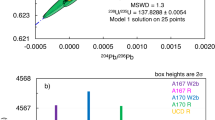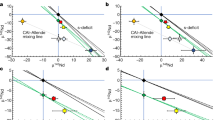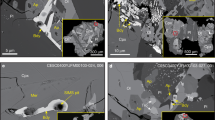Abstract
IN recent years two types of cosmochronological dating have been interpreted to indicate that there are large time intervals, a few times 107 yr, between the formation of various meteorite samples. For example, extrapolation backwards along isochrons in seven basaltic achondrites led Papanastassiou and Wasserburg1 to establish a ‘standard’ initial 87Sr/86Sr ratio of 0.69898±0.00003 (BABI≡‘basaltic achondrite best initial’). Similar isochrons in another basaltic achondrite, Angra dos Reis, led, however, to an initial ratio of 0.69884±0.0004 (ADOR≡‘Angra dos Reis’)2. The difference between these two values is attributed to the accumulation of different amounts of the 87Sr decay product of 87Rb. If this reflects a difference in the times of fractionation between Rb and Sr in the meteoritic material, then the time interval is 14×106 yr. More recently, Tatsumoto, Knight, and Allegre3 found significant differences in the radiogenic 207Pb/206Pb ratios in Angra dos Reis and in two other basaltic achondrites, the value for Angra dos Reis being 0.6197 and the average of the other two being 0.6081. These nuclides result from the decay of 235U and 238U. If the differences are attributed to different times for the events of lead–uranium fractionation in the meteoritic materials, then the indicated time interval is 27×106 yr.
This is a preview of subscription content, access via your institution
Access options
Subscribe to this journal
Receive 51 print issues and online access
$199.00 per year
only $3.90 per issue
Buy this article
- Purchase on Springer Link
- Instant access to full article PDF
Prices may be subject to local taxes which are calculated during checkout
Similar content being viewed by others
References
Papanastassiou, D. A., and Wasserburg, G. J., Earth planet. Sci. Lett., 5, 361 (1969).
Papanastassiou, D. A., thesis, CalTech (1970).
Tatsumoto, M., Knight, R. J., and Allegre, C. J., Science, N.Y., 180, 1279 (1973).
Scalo, J. M., and Ulrich, R. K., Astrophys. J. (in the press).
Hoyle, F., and Fowler, W. A., Nature, 241, 384 (1973).
Colgate, S. A., Astrophys. J. Lett., 181, 53 (1973).
Colgate, S. A., Astrophys. J. (in the press).
Reeves, H., Astr. Astrophys., 19, 215 (1972).
Spitzer, jun., L., Diffuse Matter in Space (Interscience, New York, 1968).
Spitzer, jun., L., in Nebulae and Interstellar Matter (edit. by Middlehurst, B. M., and Aller, L. H.) (University of Chicago Press, Chicago, 1968).
Truran, J. W., and Cameron, A. G. W., Astrophys. Space Sci., 14, 179 (1971).
Cameron, A. G. W., Icarus, 18, 407 (1973).
Cameron, A. G. W., Space Sci. Rev. (in the press).
Hohenberg, C. M., Geochim. cosmochim. Acta, 34, 185 (1970).
Author information
Authors and Affiliations
Rights and permissions
About this article
Cite this article
CAMERON, A. Are Large Time Differences in Meteorite Formation Real?. Nature 246, 30–32 (1973). https://doi.org/10.1038/246030a0
Received:
Revised:
Issue Date:
DOI: https://doi.org/10.1038/246030a0
This article is cited by
-
Supernovae and the origin of the solar system
Space Science Reviews (1979)
-
Precondensed matter: Key to the early solar system
The Moon and the Planets (1978)
-
Extinct radioactive nucleus202Pb: Possible origin of isotopic anomalies of Hg in meteorites
Astrophysics and Space Science (1977)
-
On possible short-lived progenitors of fission xenon in carbonaceous chondrites
Astrophysics and Space Science (1975)
Comments
By submitting a comment you agree to abide by our Terms and Community Guidelines. If you find something abusive or that does not comply with our terms or guidelines please flag it as inappropriate.



